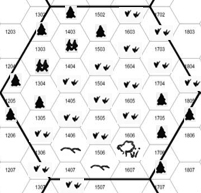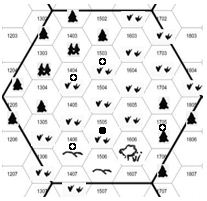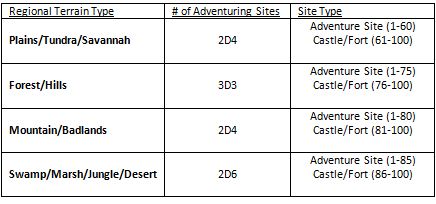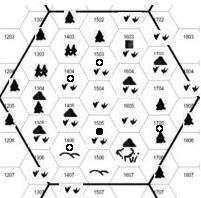Hex Basics Part III: Generating Outposts and Sites
by lorekeeper0
*photo used without permission. By Ben Powis (www.benpowis.net)*
It’s a strange phenomenon, the stocking of hexes – I find that like a good piece of art, inspiration can be hard to come by when you’re staring at a blank page. The sequential method of creating a hex map has, in my opinion, the same effect as creating “prompts” for your roleplaying; creating something visual that you can attach further meaning to. We’ve already gone from a blank hex canvas to a region populated with hills, forests and plains, and now we can begin to mentally visualize the topography.
What we have here is a plains bordered by two forests and a small marsh, potentially the basin for a small river or spring, maybe originating in the hills. Realistically, most of your regional hexes will end up looking something like this, and so to create character in the region we begin by adding abstract points of interest.
By rolling on the following table, we’ll determine the important outposts that feed into the adventuring spots we’ll generate. Note that Regional Terrain Type refers to the main terrain type of your regional hex. If you’re using Welsh Piper’s method, it’s the central hex of your region. If you’re not, its whatever terrain type is the most prominent. In our case, we’re rolling for Regional Terrain Type “plains”.
Result (1D8-1): 5. Results (5 x D100): 24(small) – 2(small) – 74(large) – 53(small) – 21(small). And so, we have 4 small outposts and 1 large one to place on the map. Place them as you see fit; given that each hex represents a 5-mile radius, what we have is a fairly populated regional area beginning to take shape. I’ve placed small towns at Hex 1404, 1406, 1503, and 1705, and one large town at Hex 1505.
Our second table is much like the first, though this time we’ll be dealing with “adventuring sites”. These are ruins, keeps, camps, fortresses, lairs, dungeons, tombs, ambushes, hideouts, or event locations, for the purpose of…adventure. We want to keep things as broad as possible, thinking of each outpost or site as a hook to hang an interesting story, encounter, or rumour.
Result (2D4): 7, Result (7D100): 56 – 46 – 8 – 82 – 50 – 42 – 4 – (6 adventure sites and 1 castle/fort). Sprinkling those in among the hex map, we have a densely populated, and potentially hotly contested, dangerous regional hex.
As you can see, our regional hex is beginning to take shape. Just from the positioning of the different points of interest you might become inspired – keep those ideas and integrate them as we move along in the process.
Next time, we’ll get into the meaty bits of defining the regional outposts.
-LK0








[…] the following table for each outpost on your regional hex, depending on its size (as was determined here). Note your results on a scrap piece of paper so you can play with them until you’re […]
[…] Hex Basics Part III: Generating Outposts and Sites […]
[…] Hex Basics Part III: Generating Outposts and Sites […]
[…] Hex Basics Part III: Generating Outposts and Sites […]
[…] following table for each outpost on your regional hex, depending on its size (as was determined here). Note your results on a scrap piece of paper so you can play with them until you’re […]